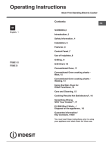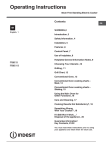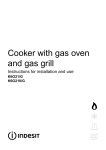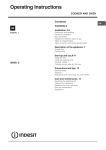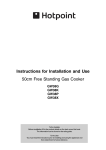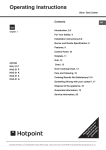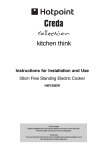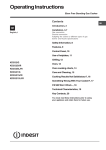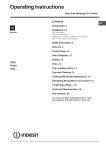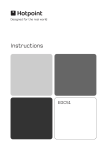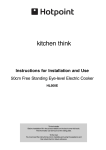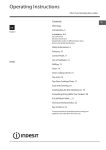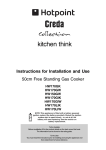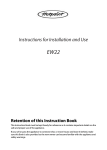Download Indesit IT50D1XX S
Transcript
Operating Instructions 50cm Free Standing Electric Cooker Contents GB English,1 WARNING, 2 Introduction, 2 Installation, 3-6 Gas connection Electrial connection Adapting the cooker to different types of gas Burner and Nozzle Specifications Safety Information, 7 Features,8 IT50D S IT50D1 S Control Panel, 9 Use of hotplates, 10 Grilling, 11 Grill Chart, 12 Conventional Oven, 13 Conventional Oven Cooking Chart MEAT, 14 Conventional Oven Cooking Chart BAKING,15 Using the Main Oven for Other Functions, 16 Care and Cleaning, 17 Cooking Results Not Satisfactory?, 18 Something Wrong With Your Cooker?, 19 If it Still Won’t Work..., 20 Technical Characteristics, 21 Key Contacts, 24 You must read these instructions prior to using your appliance and retain them for future use. GB WARNING GB WARNING: The appliance and its accessible parts become hot during use. Care should be taken to avoid touching heating elements. Children less than 8 years of age shall be kept away unless continuously supervised. This appliance can be used by children aged from 8 years and above and persons with reduced physical, sensory or mental capabilities or lack of experience and knowledge if they have been given supervision or instruction concerning use of the appliance in a safe way and understand the hazards involved. Children shall not play with the appliance. Cleaning and user maintenance shall not be made by children without supervision. WARNING: Unattended cooking on a hob with fat or oil can be dangerous and may result in fire. NEVER try to extinguish a fire with water, but switch off the appliance and then cover flame e.g. with a lid or a fire blanket. Do not close the glass cover (if present) when the gas burners or electric hotplates are still hot. WARNING: Ensure that the appliance is switched off before replacing the lamp to avoid the possibility of electric shock. CAUTION: the use of inappropriate hob guards can cause accidents. Do not use harsh abrasive cleaners or sharp metal scrapers to clean the oven door glass since they can scratch the surface, which may result in shattering of the glass. 2 The internal surfaces of the compartment (where present) may become hot. Never use steam cleaners or pressure cleaners on the appliance. Remove any liquid from the lid before opening it. ! When you place the rack inside, make sure that the stop is directed upwards and in the back of the cavity. Introduction Your new appliance is guaranteed* and will give lasting service. This guarantee is only applicable if the appliance has been installed in accordance with the installation instructions detailed in this booklet. To help make best use of your cooking equipment, please read this booklet carefully. The cooker is designed specifically for domestic use and responsibility will not be accepted for use in any other installation. ! When the cooker is first used an odour may be emitted, this will cease after a period of use. When first using the cooker ensure that the room is well ventilated (e.g. open a window or use an extractor fan) and that persons who may be sensitive to the odour avoid any fumes. It is suggested that any pets be removed from the room until the smell has ceased. This odour is due to temporary finish on oven liners and elements and also any moisture absorbed by the insulation. * The guarantee is subject to the provisions that the appliance: a. Has been used solely in accordance with the Users Instruction Book. b. Has been properly connected to a suitable supply voltage as stated on the rating plate attached to this equipment. c. Has not been subjected to misuse or accident or been modified or repaired by any person other than the authorised employee or agent. d. Has been correctly installed. 1. This appliance is intended for nonprofessional use within the home. 2. These instructions are only for those countries whose symbols appear in the booklet and on the serial no. plate of the appliance. 3. This owner’s manual is for a class 1 appliance (insulated) or class 2, subclass 1 appliances (installed between two cabinets. Installation 400 mm min 500 mm min 150 mm min Tall cupboard on the left hand side of 50cm gas cooker 65 mm min 65 mm min ! this unit may be installed and used only in permanently ventilated rooms according to the British Standards Codes Of Practice: B.S. 6172/B.S. 5440, Par. 2 and B.S. 6891 Current Editions. The following requirements must be observed: a. The cooker should not be installed in a bed sitting room with a volume of less than 20m3. If it is installed in a room of volume less than 5m3 an air vent of effective area of 110cm2 is required, if it is installed in a room of volume between 5m3 and 10m3 a supplementary airvent area of 50cm2 is required, if the volume exceeds 11m3 no airvent is required. However, if the room has a door or a window which opens directly to the outside no air vent is required even when the volume is between 5m3 and 11m3. b. During prolonged use of the appliance you may consider it necessary to open a window to the outside to improve ventilation. c. If there are other fuel burning appliances in the same room, B.S.5440 Part 2 Current Edition, should, be consulted to determine the requisite air vent feet in the plinth (900mm - 915mm). Adjust the feet by tilting the cooker from the side. Then install the product into position. Tall cupboard on the right hand side of 50cm gas cooker 750 mm min Positioning 750 mm min The following instructions should be read by a qualified technician to ensure that the appliance is installed, regulated and technically serviced correctly in compliance with current regulations. ! remember to unplug the appliance from the mains before regulating the appliance or carrying out any maintenance work. ! This appliance must not be fitted on a platform. The cooker is designed to fit between kitchen cabinets spaced 500mm apart. The space either side need only be sufficient to allow withdrawal of the cooker for servicing. It can be used with cabinets one side or both as well as in a corner setting. It can also be used free-standing. Adjacent side walls which project above hob level, must not be nearer to the cooker than 150mm or 65mm (Fig. A) and should be protected by heat resistant material. Any overhanging surface or cooker hood should not be nearer than 750mm. (Fig.A) a . The cooker may be located in a kitchen, a kitonen/ diner or bed sitting room, but not in a bathroom or shower room. b ..The hoods must be installed according to the requirements in the hood handbook. c . The wall in contact with the back of the cooker must be of flameproof material. d ..The cooker is fitted with a safety chain that must be attached to a hook, secured to the wall behind the appliance. ! some models can have their gas connection inverted. It is important to make sure the safety chain is always situated on the side which corresponds to the hose holder (Fig. B). 65 mm min The appliance must$only be installed by a competent person. In the UK, gas safe registered installers undertake to work to safe and satisfactory standards. Before moving your cooker check that it is cool, and switch off at the cooker control unit. Movement of your cooker is most easily achieved by lifting the front as follows: Open the grill door sufficiently to allow a comfortable grip on the underside front edge of the oven roof, avoiding any grill elements. ! Take care in moving the Moving the Cooker cooker as it is heavy. Take care to ensure that any floor covering is not damaged. (see figure) Splashplate optional, apply to Parts Department (see Back Cover for contact number.) 400 mm min 500 mm min Fig. A Fig. B 3 GB Gas connection Electrial connection The cooker should be connected to the gas-supply by a gas safe registered installer. During installation of this product it is essential to fit an approved gas tap to isolate the supply from the appliance for the convenience of any subsequent removal or servicing. Connection of the appliance to the gas mains or liquid gas must be carried out according to the prescribed regulation in force, and only after it is ascertained that it is adaptable to the type of gas to be used. If not, follow the instructions indicated in the paragraph headed “Adaptation to different gas types”. On some models the gas supply can be connected on the left or on the right, as necessary; to change the connection, reverse the position of the hose holder with that of the cap and replace the gasket (supplied with the appliance). In the case of connection to liquid gas, by tank, use pressure regulators that conform to the regulation in force. The gas supply must be connected to the left of the appliance. Be sure that the hose does not pass through the rear of the cooker touching hot parts. Electric cookers come without a power supply cable. The cooker is designed to operate on an electricity supply which conforms to the electrical data shown on the Rating Plate. The cooker can be connected to the mains only after removing the back panel of the cooker itself with a screwdriver. ! the following installation procedure must be carried out by a qualified electrician. The electrical installation must comply with the IEE Regulations, Building & local By-Lays. For the installation of the feeding cable carry out the following operations: • Using a screwdriver, prise on the side tabs of the terminal board cover (see fig. A); • Pull and open the junction blok lid ! make sure the supply pressure conforms with the values shown in the table entitled “Caracteristics of the burners and nozzles”. When the cooker is installed between cabinets (recessed), the gas connection must be effected by an approved flexible hose with bayonet fitting (BS 669 Current Edition). The gas inlet for the cookers is a threaded G 1/2 gas female fitting. Connecting the gas supply To make the connection, a flexible hose should be used corresponding to the current gas regulations which are: • the hose must never be at any point in its lenght in contact with the “hot” parts of the cooker; • the hose must never be longer than 1,5 metre; • the hose must not be subject to any tension or torsional stress and it must not have any excessively narrow curves or bottlenecks; • the hose must be easy to inspect along its entire length to check its condition; • the hose must always be in good condition, never attempt to repair. ! the installation must comply with gas safety (installation and use) regulations 1984. In all cases for the above, by low, a qualified, gas safe approved engineer must be called for installation. HOT PARTS 600 mm GB 4 Fig. A ! The wires in the mains lead are coloured in accordance with the following code: Earth Green & Yellow Neutral Blue Live Brown As the colours of the wires in the mains lead may not correspond with the coloured 2 L markings identifying the 4 N terminals in your plug, proceed as follows: Green & Yellow wire to E ” or terminal marked “E or Fig. B coloured Green or Green & Yellow. L” or coloured Red. Brown wire to terminal marked “L N ” or coloured Black Blue wire to terminal marked “N (see fig. B). • fix the feeding cable in the special cable stop and close the cover. ! The power supply cable must have these minimum requirements: Type: H05RR-F Section: 3x1.5 mm2 Ensure that the mains cable is routed away from any brackets affixed to the rear panel and is not trapped to the rear wall when pushing the cooker into position between cabinets. When disposing of the appliance please remove the plug by cutting the mains cable as close as possible to the plug body and dispose of it as described above. Adapting the cooker to different types of gas In order to adapt the cooker to a different type of gas with respect to the gas for which it was produced (indicated on the label attached to the lid), follow these steps: a ) replace the hose holder mounted on the appliance with that supplied in the bag of “cooker accessories”. b ))Replacing the burner nozzles on the hob: • remove the grids and slide the burners from their housings; • unscrew the nozzles using a 7 mm socket spanner, and replace them with nozzles for the new type of gas (see table 1 “Burner and nozzle characteristics”). • replace all the components by repeating the steps in reverse order. c ) Minimum regulation of the hob burners: • turn the tap to minimum; • remove the knob and adjust the regulation screw, which is positioned in or next to the tap pin, until the flame is small but steady. ! in the case of liquid gas, the regulation screw must be screwed in to the bottom. • check that the flame does not turn off when you turn the tap quickly from high to low. d ))Regulating the primary air of the burners: The primary air of the burners requires no regulation. Important On completion of the operation, replace the old rating sticker with one indicating the new type of gas used. This sticker is available from our Service Centres. Note Should the pressure of the gas used be different (or vary) from the recommended pressure, it is necessary to fit a suitable pressure regulator onto the inlet pipe in compliance with current National Regulations relative to “regulators for channelled gas”. ! VERY HOT SURFACES FOOD OR GREASE ON THESE SURFACES COULD CAUSE SMOKE AND POSSIBLY EVEN BURN YOU MUST KEEP THE OVEN AND GRILL CAVITIES CLEAN ! ATTENTION DURING INSTALLATION THE FEET OF THE APPLIANCE MUST BE LOWERED SO THAT AN AIR GAP OF AT LEAST 10MM (1CM) IS LEFT BETWEEN THE BASE OF THE APPLIANCE AND THE FLOOR. 10 mm Disposing of the appliance ! ATTENTION WHEN USING THE MAIN OVEN YOU MUST ENSURE THAT THE BASE OF THE CAVITY IS NOT COVERED WITH ALUMINUM FOIL, UTENSIL OR ANY OTHER FORM OF COVERING. FAILURE TO DO THIS MAY RESULT IN THE CAVITY BEING DAMAGED. 5 GB Burner and Nozzle Specifications GB Table 1 Liquid Gas Burner Diameter (mm) Thermal Power kW (p.c.s.*) Nominal Reduced Flow* g/h Nozzle 1/100 (mm) (mm) *** ** (mm) Flow* l/h Fast (Large)(R) 100 3.00 0.7 41 87 218 214 128 286 Semi Fast (Medium)(S) 75 1.90 0.4 30 70 138 136 104 181 Auxiliary (Small)(A) 51 1.00 0.4 30 52 73 71 76 95 28-30 20 35 37 25 45 Nominal (mbar) Minimum (mbar) Maximum (mbar) Supply Pressures * ** *** At 15°C and Propane Butane Natural S A IT50D S IT50D1 S 6 By-Pass Nozzle 1/100 1/100 Natural Gas S R 1013 mbar- dry gas P.C.S. = 50,37 MJ/Kg P.C.S. = 49,47 MJ/Kg P.C.S. = 37,78 MJ/m3 20 17 25 Safety Information When used properly your appliance is completely safe but as with any electrical product there are certain precautions that must be observed. PLEASE READ THE PRECAUTIONS BELOW BEFORE USING YOUR APPLIANCE. Always • Remove all packing from inside the oven and grill compartments before switching on for the first time. • Understand the controls prior to using the appliance. • Keep children away from the appliance when grilling as the surfaces will get extremely hot during and after use. • Turn controls off when you have finished cooking and when not in use. • Stand back when opening an oven door to allow any build up of steam or heat to disperse. • Use dry good quality oven gloves when removing items from the oven/grill. • Place pans centrally over the hotplate making sure handles are kept away from the edge of the hob and cannot become heated by other hotplate/pans. • Take care to avoid heat/steam burns when operating the controls. • Turn off the electricity supply at the wall switch before cleaning and allow the appliance to cool. • Make sure the shelves are in the correct position before switching on the oven. • Keep the oven and grill doors closed when the appliance is not in use. • Take care when removing items from the grill when the lower oven is on as the contents will be hot. • Keep the appliance clean, as a build up of grease or fat from cooking can cause a fire. • Follow the basic principles of food handling and hygiene to prevent the possibility of bacterial growth. • Keep ventilation slots clear of obstructions. • Refer servicing to a qualified appliance service engineer. • Take care to avoid touching heating elements inside the oven, as during use the oven becomes hot. Never • Never line the interior of the oven with foil as this may cause the appliance to overheat. • Never leave children unsupervised where a cooking appliance is installed as all surfaces will be hot during and after its use. • Do not allow children or persons who are not familiar with the appliance to use it, without supervision. • Never allow anyone to sit or stand on any part of the appliance. • Never store items above the appliance that children may attempt to reach. • Never leave anything on the hob surface when unattended and not in use. • Never remove the oven shelves whilst the oven is hot. • Never heat up unopened food containers as pressure can build up causing the container to burst. • Never store chemicals/food stuffs, pressurised container in or on the appliance, or in cabinets immediately above or next to the appliance. • Never place flammable or plastic items on or near the hob. • Never fill a deep fat frying pan more than 1/3 full of oil, or use a lid. DO NOT LEAVE UNATTENDED WHILE COOKING. • Never operate the grill with the grill door closed as this will cause the appliance to overheat. • Never use the appliance as a room heater. • Never use the grill to warm plates. • Never dry any items on either the hob or oven doors. • Never install the appliance next to curtains or other soft furnishings. • Never use steam cleaners. • The appliance should not be operated by people (including children) with reduced physical, sensory or mental capacities, by inexperienced individuals or by anyone who is not familiar with the product. These individuals should, at the very least, be supervised by someone who assumes responsibility for their safety or receive preliminary instructions relating to the operation of the appliance. • Do not let children play with the appliance. SAFETY ADVICE IN CASE OF A CHIP-PAN FIRE In the event of a chip pan fire or any other pan fire. 1. TURN OFF THE COOKER APPLIANCE AT THE WALL SWITCH. 2. COVER THE PAN WITH A FIRE BLANKET OR DAMP CLOTH, this will smother the flames and extinguish the fire. 3. LEAVE THE PAN TO COOL FOR AT LEAST 60 MINUTES BEFORE MOVING IT. Injuries are often caused by picking up a hot pan and rushing outside with it. NEVER USE A FIRE EXTINGUISHER TO PUT OUT A PAN FIRE as the force of the extinguisher is likely to tip the pan over. Never use water to extinguish oil or fat fires. 7 GB Features GB HOB VENTILATION SLOTS 1900W 1000W 1900W 3000W CONTROL PANEL GRILL/MEAT PAN WITH REMOVABLE HANDLE AND WIRE FOOD SUPPORT GRILL DOOR SWITCH GRILL MODEL & SERIAL NUMBER GRILL DOOR REMOVABLE INNER GLASS DOOR MAIN OVEN WIREWORK SHELF SUPPORTS OVEN ROD SHELVES 8 Control Panel GB GRILL INDICATOR LIGHT TIMER * ELECTRONIC INIECTION BUTTON GRILL MAIN OVEN INDICATOR LIGHT MAIN OVEN Control Knobs for the gas burners The position of the gas burner controlled by each one of the knobs is shown by a solid ring •. To light one of the burners, hold a lighted match or lighter near the burner and, at the same time, press down and turn the corresponding knob counter clockwise to the maximum E setting. Each burner can be operated at its maximum, minimum or intermediate power. Shown on the knob are the different symbols for off • (the knob is on this setting when the symbol corresponds with the reference mark on the control panel), for maximum E and minimum C . To obtain these settings, turn the knob counter clockwise with respect to the off position. To turn off the burner, turn the knob clockwise until it stops (corresponding again with the • symbol). Electronic Ignition for the Gas Hob* This device operates when a slight pressure is applied to the button marked with symbol. To light a specific burner just press the button while pushing the corresponding knob all the way in and turning it counter-clockwise until it lights. For immediate lighting, first press the button and then turn the knob . ! Should the burner flames accidentally go out, turn off the control knob and wait at least 1 minute before trying to relight. LEFT FRONT BURNER LEFT REAR BURNER RIGHT REAR BURNER RIGHT FRONT BURNER Models with Hob Gas Burner Safety Devices to Prevent Leaks * These models can be identified by the presence of the device itself. ! Since the hob burners are equipped with a safety device, you must hold the control knob in for about 3 seconds after the burner has been lighted to allow the gas to pass until the safety thermocouple has heated. Operating the control when the grill is in use In common with all cookers having controls sited above the grill compartment, care must be taken when setting the controls, due to hot air being emitted from the grill compartment. Slow cooking ‘S’ S’ setting specially designed The main oven has a ‘S to reduce energy usage. Full details of this can be found in the Slow cooking section of this book. Timer * To use the timer, the buzzer must be wound up by turning the knob one full turn clockwise; then turn it back to the desired time so that the number of minutes on the knob matches the reference mark on the panel. * Only available in certain models 9 Use of Hotplates GB Practical Advice on Using the Burners To use the burners as efficiently as possible, some basic guidelines should be followed: • Use cookware that is the right size for each burner (see table) in order to prevent the flame from spreading beyond the bottom of the cookware. • Only use cookware with flat bottoms. • As soon as the boiling point is reached, turn the knob to the lowest setting. • Always use lids with pots and pans. Burner ø Cookware diameter (cm) Fast (R) 24 - 26 Semi Fast (S) 16 - 20 Auxiliary (A) 10 - 14 Each burner is fitted with a spark ignitor for lighting the gas. To ensure rapid lighting of the burners every time they are used, the ignitors must be kept clean and dry dry. Remove any food spillage or cleaning materials from the electrode using a small nylon brush such as a tooth brush. Access to the electrode can be achieved by lifting off the loose burner parts carefully when the burners are cool. When the hotplate burner bodies and caps are removed for cleaning, be careful not to drop any food particles or cleaning materials into the burner bases, to avoid the possibility of blocking the gas jets. If aluminium based pans are used, a silvery deposit may appear on the top edge of the pan support fingers. See 'Care and Cleaning' section for cleaning information. ! On models equipped with a reduction grid, the grid should only be used with the auxiliary burner when cookware with a diameter of less than 12 cm is used. SAFETY REQUIREMENTS FOR DEEP FAT FRYING 1. Press the ignition button and then push in and turn the control knob of the chosen burner anticlockwise to the large flame symbol. Continue to press the ignition button until the sparks light the gas. 2. Turn the control knob anti-clockwise to the desired setting. Only turn the control knob between the large flame symbol and the small flame symbol for adjusting the setting. 3. To turn off, turn the control knob fully clockwise to the symbol O. 1. Never fill chip pans more than one third full with oil or fat. 2. Never leave oil or fat unattended during the heating or cooling period. 3. Never heat fat or fry with a lid on the pan. 4. Always dry food thoroughly before frying, and lower it slowly into the hot oil or fat. Frozen foods in particular will cause frothing and spitting if added too quickly. 5. Always keep the outside of the pan clean and free from streaks of oil or fat. DO NOT use the hotplate unless all pan supports are in position. DO NOT use mis-shapen pans which may be unstable. DO NOT use round base woks directly on the pan supports. DO NOT use the glass lid (if fitted) as a working surface. 10 HOW TO DEAL WITH A FAT FIRE 1. Do not move the pan. 2. Turn off the hotplate burners. 3. Smother the flames with a fire blanket or damp cloth to extinguish the fire. Do not use water or a fire extinguisher as the force of it may spread the burning fat or oil over the edge of the pan. 4. Leave the pan for at least 60 minutes before moving it. Grilling GRILLING MUST BE DONE WITH THE GRILL DOOR OPEN. CONTROL KNOBS MAY BECOME HOT DURING GRILLING. CAUTION: ACCESSIBLE PARTS WILL BECOME HOT WHEN THE GRILL IS USED - CHILDREN SHOULD BE KEPT AWAY. To operate the grill proceed as follows: • Open the grill door. • Pre-heat the grill on setting 6 for approximately 5 minutes (see chart on guide to grilling). Grill Pan Handle • Fix the grill pan handle securely in position. See below. • Food which only requires browning should be placed directly on/in the grill pan in the grill pan runner, or on the floor of the grill compartment. (the grill pan grid may be removed.) • Leave the control on setting 6 for toast, sealing and fast cooking of foods. For thicker foods requiring longer cooking turn the control to a lower setting after the initial sealing, on both sides, on setting 6. The thicker the food the lower the control should be set. ! Take care as the grill will be hot – always wear oven gloves. Always ensure that the grill pan is clean BEFORE use. Excess fat build up in the bottom of the pan could cause a fire hazard. Never line grill pan with foil. Using the grill pan kit The grill pan handle is detachable from the pan to facilitate cleaning and storage. Fix the pan handle securely before use: 1. Fit the handle to the grill pan so the external ‘hooks’ embrace the that edge of the pan (fig. 1) 2. Make sure that the middle part of the handle fits exactly the protruding support of the pan (fig .2) and holds the pan from the bottom. The food must be placed on the rack in the grill pan. Position the grill pan on top of the oven rack. The best results are achieved by placing the oven rack on the uppermost shelves. Pouring a little water into the grill pan will make the collection of grease particles more efficient and prevent the formation of smoke. 1 2 Grill Compartment as a ‘Hotcupboard’ Do not operate the grill control when using the compartment as a hotcupboard. Do take care when removing plates, dishes and utensils from the grill compartment when the oven is in use as they may become quite hot. You may need to use oven gloves when removing warmed items. 11 GB Grill Chart GB Pre - heat the grill for 5 minutes on maximum control setting before grilling GRILL CHART Food Grill Setting Approximate Cooking time Toasting of Bread products 6 3 - 10 mins. Small cuts of meat, sausages, bacon, etc. 5-6 15 - 20 mins. Chops etc. Gammon steaks Chicken pieces 5 20 - 25 mins. Wire food support used in upturned position for chicken. Fish: fingers Whole Fillets 5 10 - 20 mins. Whole fish and fillets placed in the base of the grill pan. Fish in breadcrumbs 5 15 - 20 mins. Pre - Cooked potato products 5 15 - 20 mins. Pizzas 5 12 - 15 mins. in the base of the grill pan. Browning of food 6 8 - 10 mins. Dish placed directly on base of the grill pan and pan placed on the base of the grill compartment. The settings in the above guide have been developed to cook food successfully without excessive fat spitting and splashing. 12 Conventional Oven Oven Control Heating of the oven is achieved by turning control clockwise to the required oven temperature scale on the control panel, as recommended in the temperature charts. The pilot light will immediately come on and will then automatically go off and on during cooking as the oven thermostat maintains the correct temperature. The cooking charts provided in this book are a guide only, giving approximate cooking temperatures and times. To suit personal taste and requirements, it may be necessary to increase or decrease temperatures by 10°C. The oven is fitted with two rod shelves. The oven is heated by two tubular sheathed elements located under the floor of the oven and on the oven roof, inside the cavity. It should be noted that at the end of a cooking period there may be a momentary puff of steam when the oven door is opened. This will disperse in a few seconds and is a perfectly normal characteristic of an oven with a good door seal. Oven Positions The correct positioning of food is indicated in the temperature charts. To prepare meat and poultry for roasting in your conventional oven. a. Wipe the joint, dry well with a clean cloth, kitchen tissue etc. and weigh it. Meat which has been stored in a refrigerator should be allowed to come to room temperature for approximately 30 minutes before cook ing, and frozen meat or poultry must be completely defrosted before placing in the oven. b. The weight of any stuffing used should be added to the oven ready weight of the meat / poultry before calculating the cooking time. c. Place the joint in the meat pan supplied with your cooker. Small joints weighing less than 1.75kg (31/2 lbs) should be roasted in a smaller meat pan/tin - or they may be ‘pot roasted’ - a small joint in a large meat pan causes unnecessary oven splashing and evaporation of meat juices. d. Additional fat should not be added, except for veal, very lean meat or poultry which can either be ‘larded’ with fat bacon or brushed very sparingly with cooking oil or melted fat. e. Beef, lamb, mutton and poultry may be dusted lightly with seasoned flour to give a crisp outer surface. The skin of duck and goose should be pricked to release excess fat during cooking, and the rind of pork should be scored, brushed lightly with oil, and rubbed with salt, to give crisp crackling. f. Potatoes for roasting only require to be brushed with cooking oil or melted fat. g. It is not necessary to baste when roasting in an electric oven and stock or liquid should not be added to the meat pan since this only causes unnecessary soiling, steam and condensation. For optimum cooking performance, there must be clearance between meat pan and oven sides. The meat pan must be placed lengthways in the oven to allow for air circulation. Times and Temperatures for Roasting The secret of succulent, tender meat, is not to roast it too quickly, at too high a temperature. Best results are obtained when roasting is carried out at a low temperature. When a lower temperature is used, the joint loses less weight, is more tender (too high a temperature causes meat to be tough and dry) and the splashing of fat onto the oven interior is reduced to a minimum. When a complete meal is being cooked in the oven, cooking time may need to be increased and temperature may need to be raised for approximately the last 30 minutes of the cooking period (for instance when cooking Yorkshire pudding to serve with roast beef). The suggested times and temperatures should be used as a guide, but may vary according to:1. Whether you prefer meat rare, medium or well done. 2. The size and shape of your joint. a. A short thick joint requires a longer cooking period than a long thin joint. b. A small joint under 1.5kg (3 lbs) takes longer per 450g (1 lb) cook in the time given for ‘minutes’ per 450g (1 lb) without the ‘minutes’ over added. c. Boned/rolled and stuffed joints take longer to cook through than those with a bone. ! Remember to switch off the oven control after cooking is finished. If the door of the oven is left open for long periods of time with the control switch ON, then the grill element will become hot. The correct positioning of food is indicated in the temperature charts. 13 GB Conventional Oven Cooking Chart MEAT GB ! Where times are stated, they are approximate only. Conventional Oven Meat Preheat Temperature °C Time (approx.) Position in Oven Beef Yes 190/200 25-30 mins per 450g (1lb) + 25 mins over. Lamb Yes 190/200 25-30 mins per 450g (1lb) + 25 mins over. Pork Yes 190/200 30-35 mins per 450g (1lb) + 30 mins over. Veal Yes 190/200 25-35 mins per 450g (1lb) + 30 mins over. Poultry/Game up to 4kg (8lb) Yes 180/190 18-20 mins per 450g (1lb) + 20 mins over. Turkey up to 5.5kg (12lb) Yes 190 22 mins per 450g (1lb) eg. 5.5 kg (11lb) = 242 mins Turkey over 5.5kg (12lb) Yes 180 18 mins per 450g (1lb) eg. 10 kg (22lb) = 352 mins Casserole Cooking Yes 140/160 2-2 ½ hrs In meat pan on runner 2 Runner 3 from bottom of oven Runner 3 If using aluminium foil, never: 1. Allow foil to touch sides of oven. 2. Cover oven interior with foil. 3. Cover shelves with foil. The most accurate method of testing the readiness of joints of meat or whole poultry is to insert a meat thermometer into the thickest part of a joint, or the thickest part of poultry thighs, during the cooking period. The meat thermometer will indicate when the required internal temp has been reached. Beef: 14 Rare: 60°C Medium: 70°C Well Done: 75°C Lamb: Pork: Veal: 80°C 90°C 75°C Poultry: 90°C Conventional Oven Cooking Chart BAKING GB Conventional Oven Cooking Food Preheat Temperature and Time Position in Oven from bottom Scones Yes 210/220°C approx. 10-15 mins. Runners 1 & 3 Small Cakes Yes 180/190°C approx. 30-35 mins. Runners 1 & 3 Victoria Sandwich Yes 170/180°C 6½"-7" tins approx. 20 mins. 8"-8½" tins approx. 30 mins. Runners 1 & 3 Sponge Sandwich (Fatless) Yes 190/200°C 7" tins 15-20 mins. Runners 1 & 3 Swiss Roll Yes 200/210°C approx. 10-15 mins. Runner 4 Semi-rich Cakes Yes 160/170°C 61½-7" tins 1¼" -1½" hours 8"-9" tins 2"-2½" hours Runner 3 Shortcrust Pastry Yes 200°C depending on use Runners 2 & 5 Puff Pastry Yes 200°C approx. depending on use Runners 2 & 5 Yorkshire Pudding Yes 210/220°C 45-50 mins. Runner 5 Individual Yorkshire Puddings Yes 210/220°C approx. 20-25 mins. Runner 5 Milk Pudding Yes 150/160°C approx. 2"-2½" hours Runner 2 Baked Custard Yes 150/160°C approx. 45-55 mins. Runner 2 Bread Yes 220°C 50-60 mins reducing to 200/210°C Runners 1 & 3 Meringues Yes 100/110°C Large3½"-4½" hours Small 2½"-3" hours Runner 2 ! If soft margarine is used for cake making, temperatures recommended by the manufacturers should be followed. Temperatures recommended in this chart refer to cakes made with block margarine or butter only. 15 Using the Main Oven for Other Functions GB SLOW Setting “S” This is used for slow cooking, keeping food warm and warming plates for short periods. Extra care should be taken when warming bone china, as it may be damaged in a hot oven. DO NOT place food or plates directly on the oven floor as this could damage both the oven lining and the plates which are being warmed. Advantages of “SLOW” cooking are: The oven stays cleaner because there is less splashing. Timing of food is not as critical, so there is less fear of overcooking. Inexpensive joints of meat are tenderised. Fully loading the oven can be economical. Cooking times can be extended in some cases by up to 2 hours. Operation: 1. Place the prepared food in the main oven and ensure the door is fully closed. 2. Select ‘S’ (Slow Cooking Temperature) by turning the Main Oven Control clockwise ensuring the oven door is fully closed. Storage and re-heating of food: 1. If food is to be frozen or not used immediately, place it in a clean container and cool as soon as possible. 2. Always thaw frozen food completely in the refrigerator before re-heating. 3. Always reheat food thoroughly and ensure it is piping hot before serving. 4. Only re-heat food once. Points to consider when preparing food for “SLOW” cooking: 1. Make sure that the dishes to be used will fit into the oven ensuring enough room for air to circulate. 2. All dishes cooked on the slow setting will require a minimum of 6 hours, however, if they are cooked for 1 -2 hours longer then deterioration in their appearance may be noticed. 3. Never cook joints of meat over 2.7kg (6 Ib) or poultry over 2.0kg (4lb 8oz). We do not recommend that joints of meat or poultry are stuffed before cooking on the slow setting. 4. To seal in the meat juices, always cook meat or poultry at 170°C for 30 minutes before wrapping in foil and placing on a rack over a tin (to allow good air circulation) before turning the control to the slow setting and cooking immediately. 5. Always ensure that joints of pork and poultry are thoroughly cooked by checking with a meat thermometer before serving. 6. Always thaw frozen foods completely before cooking. We do not recommend placing frozen food in the oven to cook. 7. Always bring soups, liquids and casseroles to the boil before placing in the oven. 8. Ensure that casserole dishes have a good seal (not airtight) and cover to the top with foil to prevent loss of moisture. 9. Ensure that fruit and vegetables are cut into even sized small pieces to cook properly. 10.. Always adjust seasoning before serving. 11. If using dried red kidney beans it is important that the beans are soaked and then boiled fora minimum of 10 minutes before using in any dish to destroy any toxins. 12. When cooking fish or egg dishes it may be necessary to check during cooking to avoid overcooking. WARNING! The oven is provided with a stop system to extract the racks and prevent them from coming out of the oven.(1) As shown in the drawing, to extract them completely, simply lift the racks, holding them on the front part, and pull (2). 16 Care and Cleaning Grill Remove the grill pan and the wire grid food support, it is best to wash these items immediately after use to prevent stains from being burnt on when used again. Wipe out the Grill compartment, use a fine steel wool soap pad to remove stubborn stains from the grill runners and the floor of the compartment. Wipe over the control panel with a damp cloth and polish with a dry cloth. Ovens Remove the rod shelves and grill pan. Use a fine steel wool soap pad to remove stubborn stains from the rod shelves, grill pan and the floor of the oven. Oven Shelf Supports Do not use cream cleaners, oven cleaners or aerosols, scouring pads or abrasive powder for cleaning the plastic knobs as damage will occur. The shelf supports are removable and dishwasher safe. To remove hold the support at the front and pull away from the oven side, this can then be cleaned in a sink or a dishwasher. When removed it allows access to the oven side, which can be cleaned with warm soapy water. To refit the support, insert the longer leg into the rear fixing hole and push in the front leg. Decorative Trims Oven Lamp Replacement Control Panel It is advisable to clean the decorative trims regularly to prevent any build up of soiling. The recommended method of cleaning is to wipe over the trims with a soft cloth wrung out in warm water or mild non-abrasive cleaner. (If in doubt try the cleaner on a small area of trim which is not noticeable in normal use). Then, after wiping with a cloth wrung out in clear water, dry with a soft clean cloth. Doors Wipe over the outer door glass panels with a cloth wrung out in warm soapy water, then after wiping with a cloth wrung out in clear water, dry with a soft clean cloth. Ensure that glass doors are not subjected to any sharp mechanical blows. Glass Inner Door Panel (where fitted) – open the door fully and unscrew the two screws securing the glass panel, taking care not to allow the glass to fall. The glass panel may now be washed at the sink. Stubborn stains can be removed by using a fine steel wool soap pad. Ensure the glass panel is not subjected to any sharp mechanical blows. Take particular care not to damage the inner surface which is coated with a heat reflective layer. After cleaning, rinse and dry with a soft cloth. For slight soiling the inner glass panel may be cleaned, while still warm, without removing it from the door. ! Oven must not be operated with inner door glass removed. Take care during cleaning not to damage or distort the door seals. Do not lift the door seal from the oven chassis, if necessary remove the seal by carefully unhooking the corner clips. Take care that the rating label edges are not lifted during cleaning, and furthermore that the lettering is not blurred or removed. GB Open the oven door and remove the rod shelves. Using a suitable cloth to protect the fingers grip the light glass dome, unscrew anti-clockwise and lift. Reach into the aperture with fingers, and unscrew the lamp anticlockwise. Fit replacement lamp (15W 300°C rated SES), refit dome. ! To avoid electric shocks - please ensure that the electricity supply to the appliance is switched off and the appliance is fully cold, before removing the lamp lens. Respecting and conserving the environment • Whenever possible, avoid pre-heating the oven and always try to fill it. Open the oven door as little as possible because heat is lost every time it is opened. To save a substantial amount of energy, simply switch off the oven 5 to 10 minutes before the end of your planned cooking time and use the heat the oven continues to generate. • Keep gaskets clean and tidy to prevent any door energy losses • If you have a timed tariff electricity contract, the “delay cooking” option will make it easier to save money by moving operation to cheaper time periods. • The base of your pot or pan should cover the hot plate. If it is smaller, precious energy will be wasted and pots that boil over leave encrusted remains that can be difficult to remove. • Cook your food in closed pots or pans with well-fitting lids and use as little water as possible. Cooking with the lid off will greatly increase energy consumption • Use purely flat pots and pans • If you are cooking something that takes a long time, it's worth using a pressure cooker, which is twice as fast and saves a third of the energy. 17 Cooking Results Not Satisfactory? GB 18 Problem Check Grilling Uneven cooking front to back Ensure that the grill pan is positioned centrally below the grill element. Fat splattering Ensure that the grill is not set to too high a temperature. Oven Baking Uneven rising of cake Ensure that the oven shelves are level by using a spirit level on the rod shelf and adjusting, using suitable packing e.g. wood, under the feet of the appliance. This should be checked both left to right and front to back. Ensure that the food is positioned centrally in the oven. Sinking of cakes The following may cause cakes to sink: 1. Cooking at too high a temperature. 2. Using normal creaming method with soft margarine. Over/Under cooking Fast/Slow cooking Refer to the cooking times and temperatures given in the oven temperature charts, however, it may be necessary to increase or decrease temperatures by 10°C to suit personal taste. Do not use utensils greater than 2¼ ins in height. Something Wrong with your Cooker? Before contacting your nearest Service Centre/Installer, check the problem guide below; there may be nothing wrong with your cooker. Problem GB Check Ignition does not work Hotplate Burner Hob Top If all burners fail to ignite: Check that sparks appear at the burners; A clicking noise should be heard. If not Check that the plug is plugged in to a 13amp Electric socket and the supply is switched on. If all burners still fail to ignite Check and replace if necessary the 13amp fuse Burner Ports Ignitor If only one burner fails to ignite Check that the burner is dry and that spillage of food or cleaning fluid remains are not affecting the Ignitor or burner ports. Clean away any debris with a dry nylon brush such as an old dry toothbrush. If a wire wool pad has been used for cleaning around the burner ensure the Ignitor is free from any stray strands. Any water on the burner should be dried with a cloth or kitchen towel. Oven Temperature seems too high or too low Oven does not cook evenly. On the hotplate make sure that all burner parts are correctly seated Check that the temperature has been set in accordance with the temperature charts. It may be necessary to increase or decrease the recommended temperature by 10 C to suit your taste Check the tem perature and shelf position are as recommended in the temperature charts Check that the Utensil being used in the oven allow sufficient air flow around them. Hotplates are slow to boil or will not simmer Odour or smoke when using your new cooker Condensation / Steam in the Oven After Use Condensation on the Wall at the Rear of the Cooker Hob Burner Ignites, but goes out when the control knob is released Check that the cooker is level. Check that your pans conform to the recommendations in these instructions. This is normal and should cease after a short period. Condensation and steam is a by product of cooking food with a water content. To help minim ise always: A) Try to avoid leaving food in the oven to cool after being cooked B) Use a coved Utensil wherever possible Steam and/or condensation may appear from the vent at the rea the appliance when using an oven, particularly when cooking foo with a high water content (Such as Oven Chips or Chicken). This is normal and any excess should be wiped off Models with Hob Gas Burner Safety Devices to Prevent Leaks * Hold the control knob for 3-7 sec after lighting the burner to allow gas to pass until the safety thermocouple has heated 19 If It Still Won’t Work... GB Contact the Service Office (0870 6070805) If something is still wrong with your appliance after you have been through the ‘Something Wrong’ list: 1. Switch off and unplug the appliance from the mains. 2. Call your nearest Service Office or local importer. When you contact us we will want to know the following: 1. Your name, address and postcode. 2. Your telephone number. 3. Clear and concise details of the fault. 4. The Model number and the Serial number of your appliance. 5. The date of purchase (please keep the receipt as evidence will be required when an engineer calls) enter the date here: ............................................................................. Please make sure you have all these details ready when you call. 20 Spare Parts Please remember your new appliance is a complex piece of equipment. ‘DIY’ repairs or unqualified and untrained service people may put you in danger, could damage the appliance and might mean you lose cover under the Parts Guarantee. If you do experience a problem with the appliance don’t take risks, call in our Service Engineer. Our Parts are designed exclusively to fit your appliance. Do not use them for any other purpose as you may create a safety hazard. Disposal of your product To minimise the risk of injury to children please dispose of your product carefully and safely. Remove all doors and lids. Remove the mains cable (where fitted) by cutting off flush with the appliance and always ensure that no plug is left in a condition where it could be connected to the electricity supply. To help the environment, Local Authority instructions should be followed for the disposal of your product. Technical Characteristics The European Directive 2002/96/EC on Waste Electrical and Electronic Equipment (WEEE), requires that old household electrical appliances must not be disposed of in the normal unsorted municipal waste stream. Old appliances must be collected separately in order to optimise the recovery and recycling of the materials they contain and reduce the impact on human health and the environment. The crossed out “wheeled bin” symbol on the product reminds you of your obligation, that when you dispose of the appliance it must be separately collected. Consumers should contact their local authority or retailer for information concerning the correct disposal of their old appliance. Mains frequency and voltage of the electric section and characteristics of the gas section Model Gas section Class IT50DS IT50D1S II2H3+ Electric section Rated power kW (1) Voltage 7,80 (567 g/h - G30) (557 g/h - G31) 230-240V~ 50/60Hz 3200-3450 W (1) The values in g/h refer to the capacities with liquid gas (Butane, Propane). TABLE OF CHARACTERISTSICS Main oven dimensions width 40,5 cm height 37 cm depth 41 cm Main oven Volume 62 l Burners Adaptable for use with all the types of gas indicated on the data plate. Voltage and frequency see data plate ENERGY LABEL and ECODESIGN Regulation (EU) No 65/2014 supplementing Directive 2010/30/EU. Regulation (EU) No 66/2014 implementing Directive 2009/125/EC. Standard EN 60350-1 Standard EN 50564. Standard EN 30-2-1 Declared energy consumption for Natural convection Class heating mode: Convectional This appliance conforms to the following European Economic Community directives: 2006/95/EC dated 12/12/06 (Low Voltage) and subsequent amendments – 2004/108/EC dated 15/12/04 (Electromagnetic Compatibility) and subsequent amendments 2009/142/EC of 30.11.09 (Gas) and subsequent modifications (only for models which use gas) - 93/68/EEC dated 22/07/93 and subsequent amendments. 2002/96/EEC 1275/2008 (Stand-by/ Off mode) 21 GB GB 22 GB 23 04/2014 - 195121990.00 XEROX FABRIANO Repair Service and Information Desk UK: 0870 6070805 GB (Open 8am to 5.30pm Mon - Fri 9am to 5pm Sat and 10am to 4pm Sun Closed Bank Holidays) Note: Our operators will require the following information:Model Number: Serial Number: Extended Warranty To join: UK 0870 442 7661 (Open 8 to 8 Mon-Sun) Genuine Parts & Accessories Mail Order Hotline To join: UK 0870 558 5850 (Open 8.30 to 5 Mon-Fri and 8.30 to 12 Sat). All Services are offered as an extra benefit and do not affect your statutory rights. Indesit Company S.P.A. Viale Aristide Merloni,47 60044 Fabriano (AN) www.indesit.com 24


























